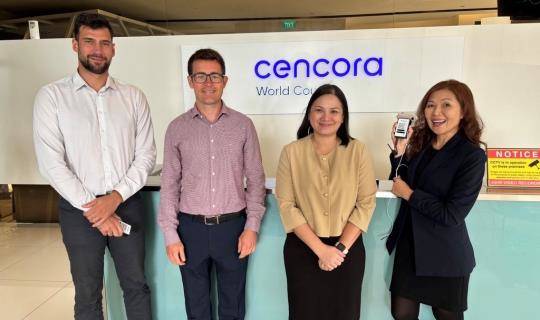Article: Will real-time tracking keep your biopharma shipment safe?
By World Courier

The right temperature control solution may be all
you need
Recent decades have seen a proliferation of temperature-sensitive, complex specialty drugs. Meanwhile, globalized supply chains have extended, often expanding into remote regions with poor infrastructure. These simultaneous trends have made temperature control a major priority for many biopharmaceutical manufacturers.
The emergence of the Internet of Things (IoT) has enabled logistics providers like World Courier to offer real-time monitoring of both the location and temperature of individual consignments, equipping us with the ability to rapidly intervene in the event of a temperature excursion – a feature supply chain leaders are understandably enthusiastic about.
But such real-time monitoring solutions come at a cost that often outweighs the risk associated with lower-value pharmaceutical shipments. Further, by choosing and conditioning the right packaging for the intended transport lane – getting the basics right – risk can usually be minimized to such a degree that remote GPS or GSM tracking is unnecessary.
The limitations of real-time monitoring
As consumers, we are becoming used to real-time
tracking for even the smallest packages. And remote monitoring comes with the
sheen of new technology. But for temperature control, even the most advanced
systems have two major limitations.
First, real-time monitoring relies on an active,
uninterrupted internet connection. While a shipment is airborne – inaccessibly
stowed in the cargo hold – temperature readings are logged, but cannot be
transmitted live for the majority of technical solutions, for safety reasons.
The same situation occurs in remote regions with patchy cellular coverage.
Retrospective readings are undoubtedly valuable in
confirming the shipment’s integrity – crucial data for certain therapies – but
if anything should happen while the consignment is in flight, it may be
too late to intervene when it’s back on the ground.
Second, real-time monitoring is most valuable when
the facilities to intervene are available – which is not always the case. For
example, Cambodia’s Phnom Penh International Airport has no freezer, and only one
refrigerator, operating at a single unverified, uncontrolled temperature range.
There simply aren’t the tools to extend sub-zero temperatures for packages tied
up in customs.





Minimizing risk with packaging
The solution is to minimize the risk of excursion in the first place, principally by ensuring the shipment’s packaging is suitable for its transport lane.
For example, an expanded polystyrene (EPS) package, cooled with frozen gel packs, is usually fine for getting a low-volume pharma consignment to its destination over a short distance, within temperature range. But EPS packages are unlikely to withstand the strain of an overseas journey with various climate zones. A flight container lined with vacuum insulated panels (VIPs) offers more protection.
How those panels are configured will depend on the contents of the package, the duration of the journey, and the environmental conditions of that journey. The flight from London to New York is roughly as long as to Dubai, but the external conditions are wildly different. Similarly for New York in the summer and winter.
Industry standard ratings exist for all temperature control solutions, verifying how long a package can maintain a given temperature both for summer and winter – known as pre-qualification. But the measurements are limited, expressing seasonal differences specific to Kentucky and Tennessee, USA.
That’s why World Courier developed its own in-house laboratory to test and qualify packaging according to environmental features specific to individual lanes – stress-testing beyond industry measures. Having undergone such rigorous testing, we can be sure this packaging will maintain range for that journey on that lane.
Planning for contingencies
Of course, things don’t always go to plan. French transport strikes can nullify European air routes. Tornados may reduce routing opportunities. Icelandic volcanoes can unexpectedly erupt. Global pandemics can instigate perpetually shifting travel restrictions.
Part of selecting the appropriate packaging then, is ensuring it can maintain range across contingency routes, as well as the proposed lane. If the shipment must be transported cryogenically, alternative lanes must provide facilities for refreshing liquid nitrogen. If the consignment may have to travel through Brazil or Mexico, the packaging must have been temperature-tested while empty – a regionally specific regulatory requirement. Lanes and packaging have a reciprocal push/pull relationship.
Failure to factor contingencies into account may
result in consignments languishing in customs or ill-equipped depots, journey
durations lapsing past the package’s pre-qualified transit time. In such cases,
real-time monitoring will serve only to confirm the exact time of excursion; an
eventuality already expected.
If reroutes and delays have been planned for,
shipment integrity can be maintained simply by executing the plan.
Prevention is the best medicine
All of which is to say that comprehensive risks
evaluation and supply chain planning is the most effective path to preventing
biopharma temperature excursions and delays.
Real-time monitoring is a crucial safety net for
mission critical shipments such as individualized gene therapies and experimental
trial doses. With informed route design, providing opportunities for
intervention should the temperature waver, real-time monitoring can and does
save lives.
There will undoubtedly come a time when the cost of real-time
monitoring solutions has fallen to such an extent that it comes as standard.
But if logistics is the careful art of balancing cost, time, and risk, active
monitoring can usually be culled on the grounds of cost, while still arriving
at an optimal solution.
And when real-time monitoring is appropriate, it
remains essential to get that delicate balance between packaging and lane
correct. Even when you have the medicine, it’s better not to need it.



